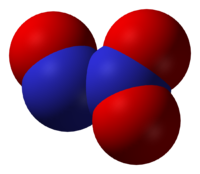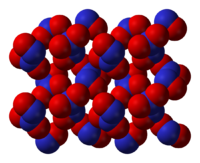- Dinitrogen trioxide
-
Dinitrogen trioxide 
 Other namesNitrous anhydride, nitrogen sesquioxide
Other namesNitrous anhydride, nitrogen sesquioxideIdentifiers CAS number 10544-73-7 PubChem 61526 ChemSpider 55446 
ChEBI CHEBI:29799 
Jmol-3D images Image 1 - [O-][N+](=O)N=O
Properties Molecular formula N2O3 Molar mass 76.01 g/mol Appearance deep blue liquid Density 1.4 g/cm3, liquid
1.783 g/cm3 (gas)Melting point −100.1 °C (173.05 K)
Boiling point 3 °C (276 K)
Solubility in water very soluble Structure Molecular shape planar, Cs Thermochemistry Std enthalpy of
formation ΔfHo298+91.20 kJ/mol Standard molar
entropy So298314.63 J K−1 mol−1 Hazards EU Index Not listed EU classification Highly toxic (T+) NFPA 704 Flash point Non-flammable Related compounds Related nitrogen oxides Nitrous oxide
Nitric oxide
Nitrogen dioxide
Dinitrogen tetroxide
Dinitrogen pentoxide
Nitrogen trioxideRelated compounds Nitrous acid  trioxide (verify) (what is:
trioxide (verify) (what is:  /
/ ?)
?)
Except where noted otherwise, data are given for materials in their standard state (at 25 °C, 100 kPa)Infobox references Dinitrogen trioxide is the chemical compound with the formula N2O3. This deep blue liquid is one of binary nitrogen oxides. It forms upon mixing equal parts of nitric oxide and nitrogen dioxide and cooling the mixture below −21 °C (−6 °F):[1]
Dinitrogen trioxide is only isolable at low temperatures, i.e. in the liquid and solid phases. At higher temperatures the equilibrium favors the constituent gases, with Kdiss = 193 kPa (25 °C).[2]
Structure and bonding
Typically, N–N bonds are similar in length to that in hydrazine (145 pm). Dinitrogen trioxide , however, has an unusually long N–N bond at 186 pm. Some other nitrogen oxides do also possess long N–N bonds, including dinitrogen tetroxide (175 pm). The N2O3 molecule is planar and exhibits Cs symmetry. The dimensions displayed below come from microwave spectroscopy of low-temperature, gaseous N2O3:[1]
It is the anhydride of the unstable nitrous acid (HNO2), and produces it when mixed into water. An alternative structure might be anticipated for the true anhydride, i.e. O=N–O–N=O, but this isomer is not observed. If the nitrous acid is not then used up quickly, it decomposes into nitric oxide and nitric acid. Nitrite salts are sometimes produced by adding N2O3 to solutions of bases:
- N2O3 + 2 NaOH → 2 NaNO2 + H2O
References
External links
Categories:- Oxides
- Inorganic nitrogen compounds
- Acidic oxides
- Acid anhydrides
- Sesquioxides
Wikimedia Foundation. 2010.


